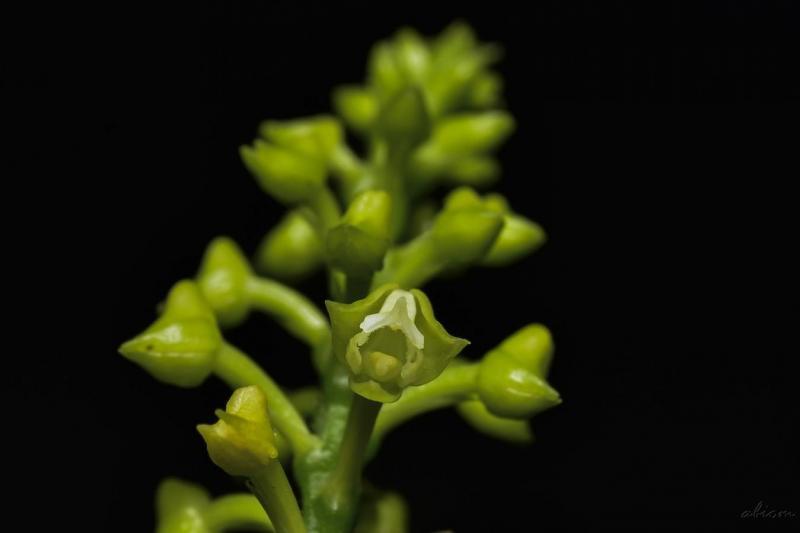Polystachya concreta
Also known as: Pale Flowered Polystachya or Polystachya zanguebarica Polystachya tricruris Polystachya rufinula Polystachya jussieuana Polystachya praealta Polystachya gracilis Polystachya lettowiana Polystachya latifolia Polystachya lehmbachiana Polystachya lepidantha Polystachya hypocrita Polystachya minuta Polystachya luteola var. racemifera Polystachya luteola var. tincta Polystachya tessellata var. tricruris Polystachya luteola var. exsanguis Polystachya tessellata ssp. tricurus Polystachya luteola var. paniculata Dendrorkis polydendris Polystachya purpurea var. lutescens Polystachya extinctoria Polystachya penangensis Polystachya kraenzliniana Polystachya siamensis Polystachya purpurea Polystachya pleistantha Polystachya singapurensis Polystachya concreta h.v. tricuris Polystachya zeylanica Polystachya colombiana Polystachya caquetana Polystachya zollingeri Epidendrum minutum Cranichis luteola Epidendrum concretum Polystachya cubensis Polystachya reichenbachiana Polystachya dagremondiana Polystachya tricuspidata Dendrorkis tessellata Dendrorkis zollingeri Dendrorkis polystachyon Dendrorkis extinctoria Dendrorkis rufinula Dendrorkis purpurea Polystachya mauritiana Polystachya flavescens Dendrorkis jussieuana Dendrorkis minuta Dendrobium flavescens Callista flavescens Dendrobium polystachyum Maxillaria luteola Polystachya tessellata h.f. alba Polystachya buchananii Polystachya tessellata Polystachya luteola Dendrobium parvum Onychium flavescens Maxillaria purpurea The Greater Yellowspike in the subfamily: Epidendroideae
Native to: Belize Departamento de Copan - Honduras Departamento del Huila - Colombia Guyana India Indonesia Madagascar Mexico Parana - Brazil Sao Paulo - Brazil Thailand
General Information
Pale Flowered Polystachya is a small to medium sized cool to warm growing epiphytic orchid belonging to the sub family Epidendroideae native to Belize, Honduras, Colombia, Guyana, India, Indonesia, Madagascar, Mexico, Brazil, and Thailand.
Plant Description
Grows to 35cm. Each new growth has numerous lance shaped leaves that grow to 3-25cm long. Pseudobulbs grow to 1-6cm
Substrate(s)
- Coarse
- Bark
- Treefern
- Spaghnum Moss
Care Notes
These orchids like to be watered regulary, especially during warm weather, and prefer a well draining mix or also do well mounted, provided they can be watered daily or even many times a day.
These are quite a forgiving orchid, there are no special requirements to get this orchid to flower, just good care and consistent conditions. Larger plants may be more fussy and can react poorly to change; a poorly timed repotting, a pest infection or an unusually hot day can set them back for a couple of years. However, even plants that have been treated poorly can thrive, and if they are set back they often recover much stronger then they would otherwise be.
Climate
Grows at low to high elevations. Rainfall ranges from 36mm to 246mm per day, heaviest in September and lightest in December. Humidity ranges from 73% to 79%, highest in August and lowest in March. Temperature ranges from 12C to 33C, highest in August (22C to 33C) and lowest in January (12C to 26C).
Watering
These orchids prefer a wet-dry cycle between waterings, they should be watered frequently but only when the moisture is approaching dryness, where the pot feels light and/or the media looks dry. Keep an eye on mounted orchids in warm weather as they may dehydrate quickly.
Keep moisture levels up during hot weather as the plant is prone to dehydrationFertiliser
Apply liquid based fertiliser per recommended directions. They can benefit from a high phosphate fertiliser leading up to flowering season, followed by a high nitrogen fertiliser when new growth appears, and a balanced fertiliser in other times. These orchids can also tolerate slow release fertiliser applied 1-2 pellets per cup (250ml) of media.
Use balanced fertiliser during Spring and Summer. Apply fertiliser regularly at half strength year round. Use a high Nitrogen fertiliser during Spring and Summer. Use a high Phosphorous fertiliser during Summer.Potting
These plants are quite forgiving and will do well repotted ever 2-3 years. The mix should be coarse, well draining, and allow space for air to move and for roots to grow.
Alternatively, these plants will also do well mounted to tree fern or cork slabs, or mounted to trees.
Best time for repotting or mounting the orchids is the end of winter when new growths start to appear. Avoid repotting during hot weather,
Use water retentive media such as moss to prevent roots from drying out quickly This plant does very well in baskets or suspended pots This plant does well mounted. Repotting is best done annually and in a pot the same size or only slightly larger than the previous one.




















